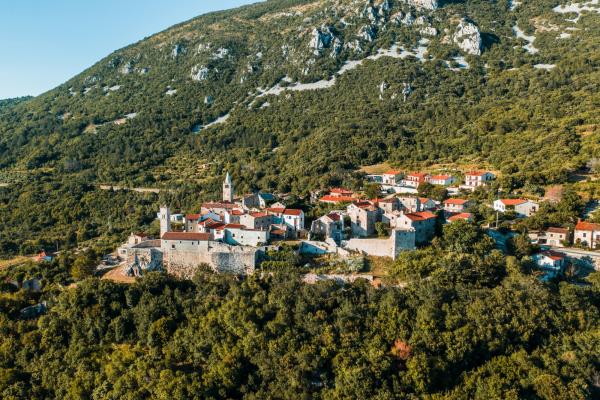PLOMIN
PLOMIN


Like this article?
Recommend it to your friends through these services..
When talking about culture, heritage and history in the area of the Kršan municipality, it is impossible to leave out Plomin, one of the oldest Istrian settlements in general. Ancient Phlanona, Italian Fianona, is another fortified town, surrounded by 13th and 14th century medieval ramparts and Renaissance defensive walls from the 16th and 17th centuries. It is located at the foot of homonymous Plomin hill, at an elevation of 168 m above Plomin Bay and its Valley. On one side, the view reaches Vela vrata on Kvarner, the island of Cres and Rijeka, while on the other, the Istrian mainland can be seen. Plomin was created on the site of a prehistoric hillfort from the 2nd millennium BC, and was ruled by Liburnians (Illyrian people who inhabited the eastern coast of Istria) in the 1st millennium BC. During antiquity, after falling under Roman rule, it became an even more important port and trading centre.
Plomin was the westernmost point of the ancient province of Dalmatia. After the fall of the Western Roman Empire, it changed several rulers - Eastern Goths, Byzantium and Lombards, and from 788 the Franks ruled over it. During the time of the Venetians, it was the most exposed Venetian fort on the east coast of Istria, and it suffered heavily in the Venetian-Austrian conflicts during the 16th and 17th centuries.
Between the world wars, it was part of fascist Italy, and welcomed the end of World War II almost devastated. Although Plomin has only about a hundred inhabitants today, its rich past and the proximity of natural sights influence the increasing number of visitors and the development of its tourist capacities.
The northern gate that once represented the entrance to the town of Plomin is still preserved today. The 15th century Parish Church of the Blessed Virgin Mary is a place where you can see an interesting Gothic crucifix and a significant fresco of the Our Lady of the Milk, a stone custodian from 1499, as well as wooden statues of St. Anthony the Hermit, Our Lady with Child and St. Rochus and Renaissance choral benches including the so-called golden altar from the 17th century. A large wall fresco by the painter Albert Costanzo was also discovered, which he painted in 1475. La Tura communal palace is located on the town square. From here a network of small and narrow streets starts that intertwine stone buildings that seem to emerge from the rocks. Plomin is adorned with Renaissance and Baroque buildings-palaces, and the record of Artemidorus from ancient Ephesus, who mentions it under the name Flánon in his writings as early as 100 BC, tells how old the place actually is. Impressive! Among the other buildings, is the 11th century Romanesque St. George's church, the first Plomin parish church dominated by a 15 m high Romanesque belfry, one of three Romanesque bell towers to be preserved in Istria. The church is widely known for the 11th century Plomin plaque built into the outer wall.
The Plomin tablet is a stone tablet with a relief depiction of the Illyrian-Roman god Silvanus - the ancient protector of flora and fauna, and a later added Glagolitic inscription. It is possible that the church was built on the site of a former Illyrian temple. The Glagolitic inscription on the relief is one of the oldest discovered Glagolitic inscriptions in general. The relief is one of the oldest materials and written documents about the presence of Slavs in these areas, and due to its historical value, was exhibited in Paris in 1971 at the Art on Yugoslavian land exhibition, and after that it was stored in Zagreb. The church facade today bears its imprint. The tablet contains the round Glagolitic script, which was used in Croatia before the angular one, and this Plomin tablet, which is supposed to be older than the Baška and Valun tablets or the Krk tablet, is considered one of the oldest monuments of the Croatian language. The 13th century crucifix also stands out in the church. It is interesting that St. George took spring, crops and horsemen under his protection. This is probably why he also gave Plomin a heavenly Istrian bellflower. St. George’s Church is worth mentioning because of the votive gifts from Plomin sailors who prayed here for protection and well-being. After all, it is a town of sailors and ship owners.
